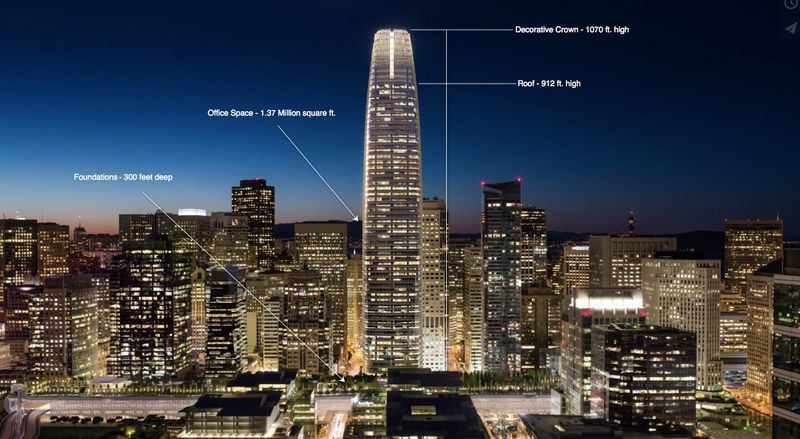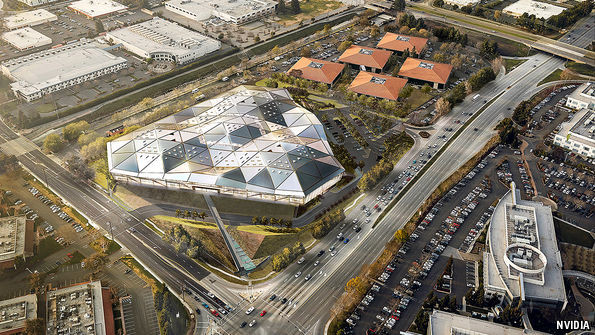Many of the nation’s leading technology firms are erecting billion dollar shrines to themselves, while hoarding cash and using the American public to pay the bill.
- Is big tech robbing the country’s revenues by declaring their intellectual property resides in offshore tax havens ?
- Are they devaluing the country’s technical labor force by using lower-wage offshore nationals ?
- Is the Governmental without objection because they are so far behind ?
- Is big tech the reason so many qualified workers are out of work ?
Big tech companies claim they won’t be competitive if they rely on US tech labor, yet all but admit they primarily use offshore labor to reduce cost and risk. They also claim that they aren’t replacing US jobs, and that’s non-sense. There is a plethora of technical talent in the US that’s out-of-work from age discrimination and the available supply of foreign workers willing to take their place at half the cost.

Salesforce Software’s new tower makes San Francisco’s old monuments look small. And It is not the only technology company erecting a shrine to itself, Apple’s employees have just begun moving into their new headquarters in Cupertino conceived by the firm’s late founder, Steve Jobs. The four-storey, circular building looks like a fat dough-nut about the same size as the Pentagon, and cost around $5 billion.
Throughout California’s Silicon Valley, cash-rich technology firms have built or are erecting bold, futuristic headquarters that convey their brands to employees and customers. Another example is Uber, a ride-hailing company, which is hoping to recast its reputation for secrecy and rugged competitiveness by designing an entirely see-through head office. It is expected to have some interior areas, as well as a park, that will be open to the public.

The exteriors of the new buildings will attract most attention, but it is their interiors that should be watched more closely. The very newest buildings, such as Apple’s, are mostly still under wraps, but they are expected to be highly innovative in their internal layout. Some of that is because of fierce competition within the tech industry for the best engineering and other talent: firms are particularly keen to come up with attractive, productive environments. But these new office spaces will also signal how work is likely to evolve. Technology companies have already changed the way people behave in offices beyond their own industry, as a result of e-mail, online search and collaboration tools such as Slack. They are doing the same for physical spaces.
The big idea championed by the industry is the concept of working in various spaces around an office rather than at a fixed workstation. Other industries have experimented with “activity-based working”, but tech is ahead. Employees may still have an assigned desk but they are not expected to be there, and they routinely go to different places to do various tasks.
There are “libraries” where they can work quietly, as well as coffee shops, cafés and outdoor spaces for meetings and phone calls. The top two floors of Salesforce Tower, for example, will be used not as corner offices for executives but as an airy lounge for employees, where they can work communally and gaze out at the views over a latté.
A fluid working environment is meant to allow for more chance encounters, which could spur new ideas and spark unexpected collaborations.
Facebook’s central building is the world’s largest open-plan office, designed to encourage employees to bump into one another in its common spaces and in a nine-acre rooftop garden. Communal areas are meant to be casual and alluring. John Schoettler, head of real estate at Amazon, says he aims to make them into “living-room-like spaces”.
The new “working at home”
The lack of fixed workstations shrinks the amount of expensive real estate given to employees without leaving them feeling too squeezed. Tech firms devote around 14 square metres to each employee, around a quarter less than other industries, according to Randy Howder at Gensler, a design firm.
Young workers are thought to be more productive in these varied environments, which are reminiscent of the way people study and live at university. One drawback, however, is that finding colleagues can be difficult. Employees need to locate each other through text messages and messaging apps.
Collaborative spaces can also expose generational tensions, says Louise Mozingo, an architecture professor at the University of California, Berkeley. Tech firms’ elderly employees (otherwise known as the over-40s) can struggle to adjust to moving around during the day and to the frequent disruptions that come from large, open-plan offices.
Many of Facebook’s employees do not like their office because it is noisy, and some Apple employees are hesitant to move into their new building for the same reason. Plenty also balk at the massive distances they will need to walk.
That may not be the only thing to cause employees concern.
Tech firms are increasingly keen to use their own products in their headquarters. Jensen Huang, the chief executive of Nvidia, a chipmaking firm whose graphics processing units are widely used in artificial-intelligence programmes, says his firm plans to introduce facial recognition for entry into its new headquarters, due to open later this year.
- Nvidia will also install cameras to recognise what food people are taking from the cafeteria and charge them accordingly, eliminating the need for a queue and cashier. A self-driving shuttle will eventually zip between its various buildings. And Nvidia’s own AI will monitor when employees arrive and leave, with the ostensible aim of adjusting the building’s heating and cooling systems.
- The data that firms can collect on their employees’ whereabouts and activities are bound to become ever more detailed. Another way of keeping tabs on people is through company-issued mobile phones. “Every employee has their own tracking device,” observes Mr Howder at Gensler. “Technology firms will sooner or later take advantage of that.”
- Few of them are willing to share details of their future plans because of concerns about employees’ privacy. However, some of their contractors signal what sort of innovations may be in the pipeline. Office-furniture makers, for example, are experimenting with putting sensors in desks and chairs, so that firms will be better able to monitor when workers are there.
Iit is not hard to imagine how such data could create a culture of surveillance, where employees feel constantly monitored. “Technology firms could be an indicator of what will happen with privacy in offices more generally,” says David Benjamin of Autodesk, a company that sells software to architects, among other clients.
A less controversial trend is for unusual office interiors. These can distinguish companies in the minds of their employees, act as a recruiting tool and also give staff a reason to come into the office rather than work from home. For companies that do not ship a physical product, such offices can serve as important daily reminders of culture and purpose.
Last year LinkedIn, a professional social network, for example, opened a new building in San Francisco that is full of space set aside for networking, and that includes a “silent disco”, where people can dance to music with headphones on. Instead of offering generic meeting rooms with portentous names, Airbnb, a tech firm that lets people rent out their homes, has designed each of its meeting spaces after one of its rental listings, such as a Bedouin tent from Morocco. It also has a meeting room (pictured above) that is an exact replica of the rental apartment where the founders lived when they came up with the idea for Airbnb. Every detail, including the statue of Jesus in red velvet on top of the fireplace, is accurate, says Joe Gebbia, one of the company’s founders.
Nvidia is obsessed with triangles, the basic element of computer graphics used to create lifelike scenes in video games and movies. Its new headquarters, which cost $370m, is shaped like one (see picture), and its interior is full of them. Everything, from the skylights to the benches in the lobby, is triangular. “At this point I’m kind of over the triangle shape, because we took that theme and beat it to death,” admits John O’Brien, the company’s head of real estate, who pointedly vetoed a colleague’s recent suggestion to offer triangle-shaped water bottles in the cafeteria.

Such workspaces remind staff that they are choosing not just an employer but a way of life. In the tech bubble of the late 1990s companies disrupted the workplace by offering foosball tables, nap pods, blow-up castles and free lunches. Now the emphasis is on amenities that help employees save time. Larger firms, including Facebook, Alphabet and LinkedIn, offer their staff something akin to the services used by the extremely wealthy, helping employees to find places to live, adopt pets and the like. Some large tech groups offer on-site health care.
The effect of all this is that the typical office at a technology firm is becoming a prosperous, self-contained village. Employees have fewer reasons than ever to leave. With the spare cash they can throw at their employees, tech giants have vastly raised the bar for other kinds of company, which also want to recruit clever engineers and techies for their projects.
Other industries would be wise to take time to watch how tech firms are structuring their work environments. There is certainly a chance of a backlash against those that use their products to watch employees too closely. Workers may like free lunches and other perks associated with the tech business, but probably not enough to surrender their privacy entirely.
Source: Economist.com